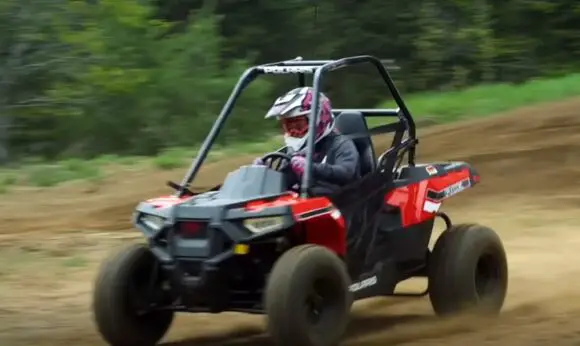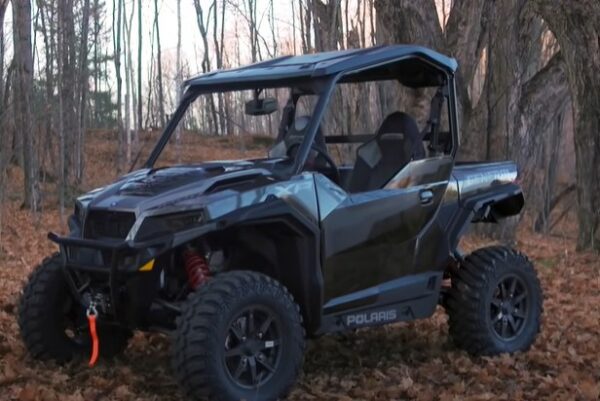Polaris Ace 150 is a great UTV for offroading, however, it also has some problems that you may face from time to time.
In this article, we’ll take a look at some of the most common problems of the Polaris Ace 150 and provide helpful fixes for each one.
Polaris Ace 150 Problems

1. Engine Issues
Engine issues are one of the most common complaints about the Polaris Ace 150.
The most frequent issue is with the engine oil, as many users do not properly maintain it and thus cause premature wear and tear.
The spark plug can also become fouled due to insufficient maintenance, which will cause the engine to run choppy at lower speeds or misfire completely when trying to accelerate.
Other common issues include faulty wiring connections between components, leaky gaskets, and worn-out cylinder walls.
Fix
To avoid these engine issues, you should regularly change the oil, check spark plugs and other connections for any signs of wear or damage, and inspect the cylinder walls for nicks or gouges.
2. Oil Leaks
Oil leaks can be a common problem in Polaris Ace 150 vehicles.
This can occur due to a variety of factors, such as worn-out gaskets and seals, broken or loose parts, or general wear and tear over time.
Fix
The most common solutions are replacing damaged parts, tightening loose bolts, and using high-quality sealant on gaskets or seals.
It is also important to regularly inspect your vehicle for signs of oil leakage in order to catch any issues before they become major problems.
3. Battery Problems
Battery problems are a common issue for Polaris ACE 150 owners.
The most common symptoms of a faulty battery include poor performance, sluggish start-up, and decreased fuel efficiency.
If your Polaris ACE 150 is experiencing these issues, it’s likely due to the battery not being able to hold a charge properly.
Fix
To fix this problem, the first thing to do is check the voltage reading on the battery itself. The optimal voltage should be between 12.5 and 13 volts for a fully charged battery.
If your reading is lower than that, you will need to replace the battery with a new one that matches the same size and capacity as the original one.
If you find that the voltage is normal but your Polaris Ace 150 still isn’t working properly, it may be due to corrosion or other damage caused by improper maintenance or storage conditions.
Inspect the connections for any signs of rust or water damage and clean them thoroughly if necessary using an appropriate electrical contact cleaner spray or solution.
Check all wires and cables leading from the battery and make sure they are securely connected before attempting to start your vehicle again.
4. Electrical System Faults
One of the most common problems encountered with a Polaris ACE 150 is an electrical system fault.
This can be caused by a variety of different issues, from faulty wiring to corroded battery terminals.
Poor maintenance or not replacing worn or damaged components can also lead to electrical system faults.
Fix
A qualified mechanic or technician should be able to identify and fix the underlying issue.
It’s important to note that some electrical system faults may require more than just a spark plug replacement – they may need more extensive repairs, such as replacing a voltage regulator or even a new alternator.
As such, it’s best to take your ACE 150 to a certified Polaris dealer for diagnosis and repair if you suspect an electrical problem.
5. Clutch Issues
The clutch is an integral part of the Polaris Ace 150’s drivetrain and is responsible for engaging and disengaging the engine. Unfortunately, problems can arise with it due to wear and tear or misuse.
Fix
Some common symptoms of a clutch issue include difficulty shifting into gear, grinding noises when shifting, or abnormally high engine revving without acceleration.
If any of these issues arise, the clutch may need to be adjusted or replaced.
Proper maintenance such as regular oil changes and inspection of the drivetrain components can help reduce the chances of having any major problems with your machine’s clutch system in the future.
6. Ignition Woes
The ignition woes of the Polaris Ace 150 can be frustrating for any rider. It is common for the starter to struggle, or even fail to turn over when trying to start.
This is often due to a faulty spark plug, which needs to be replaced in order to remedy the issue. In more serious cases, the ignition coil may need to be replaced or rebuilt as well.
Fix
Fortunately, these repair tasks are not overly complicated and can often be done with basic hand tools and a few spare parts from a local hardware store.
If you find yourself dealing with an unreliable starter on your Polaris Ace 150, make sure you take the time to troubleshoot and replace any damaged components in order to get back on the trails in no time!
7. Suspension Issues
The Polaris Ace 150 is prone to suspension issues, particularly related to the shocks. The shocks are not designed to handle uneven terrain or heavy loads and may become damaged over time.
If the Ace 150 is taken on rough terrain, it may cause damage to the shocks, leading to a bumpy ride and decreased suspension performance.
Additionally, if the Ace 150 is weighed down with components such as extra storage or passengers, this can lead to premature wear and tear on the shocks.
Fix
To prevent this issue from occurring, ensuring that you stick to flat terrain when riding, avoid adding excessive weight to the vehicle, and use proper shock maintenance will help ensure your Polaris Ace 150 maintains its suspension performance for years of dependable service.
Technical Specifications of Polaris Ace 150:
| Specification | Details |
|---|---|
| Engine | 149cc Single-Cylinder, 4-Stroke |
| Transmission | Automatic CVT with Forward and Reverse Gears |
| Fuel System | Electronic Fuel Injection (EFI) |
| Cooling | Air-Cooled |
| Suspension | Front: Single A-Arm with 5.1″ (13 cm) Travel |
| Brakes | Front and Rear Hydraulic Disc Brakes |
| Tires | Front: 22 x 7-10 |
| Dimensions (L x W x H) | 85.2″ x 48″ x 57″ (216.4 cm x 121.9 cm x 144.8 cm) |
| Wheelbase | 65″ (165.1 cm) |
| Ground Clearance | 9.8″ (25 cm) |
| Fuel Capacity | 2.5 Gallons (9.5 Liters) |
| Weight | Approx. 569 lbs (258 kg) |
| Seating Capacity | Single Seat |
| Recommended Age | 10 and Older |
| Safety Features | Roll Over Protective Structure (ROPS) |
| Lighting | Halogen Headlights |
Pros and Cons
Pros:
- Youth-Friendly Design: The ACE 150 is specifically engineered for younger riders, making it a great introductory vehicle for kids getting into off-roading.
- Safety Features: It includes a variety of safety features such as adjustable speed limiting, seat belts, and a protective cage, ensuring the safety of the rider.
- EFI for Improved Start: The Electronic Fuel Injection (EFI) provides consistent starting, improves performance, and handles high-altitude riding.
- Comfortable and Intuitive: It comes with a comfortable seat, adjustable steering wheel, and easy-to-use controls, making the driving experience enjoyable for kids.
- Suspension: The vehicle has a long-travel front and rear suspension, making the ride smoother over rough terrain.
Cons:
- Limited Power: As it’s designed for youth riders, the ACE 150 isn’t as powerful as adult ATVs or UTVs. This may be restrictive for older or more experienced riders.
- Size Limitations: Due to its compact design, it might not be suitable for larger or taller teenagers.
- Resale Value: As riders grow and develop their skills, they may outgrow the ACE 150 relatively quickly, and the market for used youth vehicles might be smaller than that for adult-sized ones.
Conclusion
The Polaris Ace 150 can be a great choice for people looking for an off-road vehicle that provides plenty of power and performance.
However, as with any machine, it is important to keep up on maintenance and repairs in order to ensure optimal performance.
If you experience any issues or problems while operating your Polaris Ace 150, consult your owner’s manual or contact your local authorized dealer immediately.
FAQs
What is the top speed of a Polaris ACE 150?
The Polaris ACE 150 has a top speed of 25 mph.
Does Polaris ACE 150 have a reverse?
Yes, the Polaris ACE 150 has a reverse gear feature. It allows you to drive backward at a slow speed for maneuvering or in tight spaces.
How do you adjust the speed on a Polaris ACE 150?
The speed on a Polaris ACE 150 can be adjusted using the controls on the handlebars.
These controls allow you to increase or decrease the engine’s throttle, which will adjust your speed accordingly.
You can also use the brakes to slow down or stop, as needed.
Polaris Magnum 425 4×4 Problems


